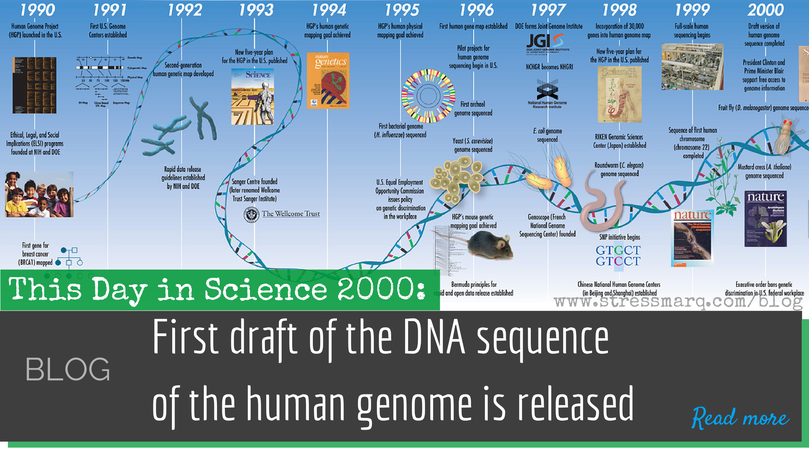Leslie Rietveld | June 26th, 2014 | This Day in Science
“It’s a history book – a narrative of the journey of our species through time. It’s a shop manual, with an incredibly detailed blueprint for building every human cell. And it’s a transformative textbook of medicine, with insights that will give health care providers immense new powers to treat, prevent and cure disease.” – Francis Collins
On June 26th, 2000 an initial rough draft of the human genome was released by the Human Genome Project. The announcement was made in the White House by Dr. Francis Collins, with remarks from Bill Clinton, Tony Blair, and Craig Ventor.
Who did it?
Dr. Alvin Trivelpiece
Photo Credit: [Oak Ridge National Laboratory, U.S. Dept. of Energy]
The project was initially proposed in 1987 by Dr. Alvin Trivelpiece, and was estimated to take 15 years with the technology of the day.
The clock started on the project officially in 1990 with funding from both the Department of Energy (DOE) and the National Institutes of Health (NIH). The program was initially led by David Galas from the DOE and James Watson, head of the NIH Genome Program. James Watson is one of the original scientists who proposed the double helix structure of DNA back in 1953.
James Watson and Francis Crick with a model of the DNA molecule, the double helix.
Copyright: A. Barrington Brown/Science Source/Photoresearchers.
In 1993 Francis Collins replaced Watson as director of the NIH National Human Genome Research Institute.
Dr. Francis Collins, current director of the NIH.
Photo Credit: [United States Department of Health and Human Services]
The actual sequencing was completed by numerous universities in the United States, the United Kingdom, France, Germany, Japan, and China.
How long did it take?
Human DNA sequencing finally began in 1996 in six universities across the United States. The project steamed ahead due to advances in the field of genomics, and large scale sequencing began in 1999. It was estimated to take 15 years, but the project was completed in 2003, 2 years earlier than expected.
Timeline showing the progress of the Human Genome Project in recent years, and the discoveries that built the foundation for the project starting back in 1865.
How did they do it?
Human chromosomes are between 50-300 million base pairs in size. In order make the task of sequencing them more manageable, the chromosomes were broken into fragments and then cloned into bacterial artificial chromosomes (BACs).
Diagram of DNA sequencing method used in the Human Genome Project.
Photo Credit: [Abizar Lakdawalla].
These BACs replicate the DNA in order to create a large enough quantity to allow for sequencing. Each fragment is sequenced about 10 times by a sequencing machine. These cloned fragments overlap, so that the whole sequence can be strung together to make up the final complete chromosome sequence.
What exactly did they do?
Not only did they sequence 3 billion bases to 99.99% accuracy, they also mapped locations of genes in our chromosomes, and produced linkage maps showing how genetic traits can be tracked through generations. This wealth of data was updated daily and deposited in a database that was freely accessible for all to use.
Statistics on the number of genes and base pairs per chromosome.
What did they find?
We have approximately 20,000 genes, far fewer than first thought. The genome also has much more duplicated material than other genomes, with only 1.5% actually coding proteins. Some of the remaining 98.5% of the genome is transcribed into functional non-coding RNA strands that act as origins of replication, centromeres, and telomeres.
The human genome, categorized by function of each gene product, given both as number of genes and as percentage of all genes.
Whose DNA was is?
Two male and two female donors were randomly selected from a pool of 20 volunteers. The identity of the final 4 donors remains unknown even to them.
How much did it cost?
The project was estimated to cost $3 billion but it came in under budget at $2.7 billion.
Is it finished?
As finished as it can be with the current technology. There is about 1% remaining that is not sequenced, and a new method will need to be created to sequence those missing pieces.What’s the big deal?
The genetic origins of 1,800 diseases have been discovered thanks to the Human Genome Project. Researchers can now find a gene suspected in a disorder in few days, instead of years. We can now perform genetic testing for more than 2,000 different conditions, assisting with diagnosis and risk assessment.
Now what?
In 2005 HapMap started to characterize all the single-nucleotide polymorphisms across individuals and populations.
A Single Nucleotide Polymorphism is a change of a nucleotide base at a single location on a strand of DNA.
Similarly, the Cancer Genome Atlas wants to map all the genetic abnormalities found in various types of cancer. These efforts will pinpoint the specific areas where our genomes differ, and allow for targeted sequencing in the areas of high variation. The aim is to discover the genetic origins of human disease, leading to improved diagnosis, treatment, and prevention across the spectrum of disorders.
Check out the National Human Genome Research Institute for a wealth of information on the Human Genome Project and this excellent interactive timeline covering key discoveries in genetics.










Leave a Reply